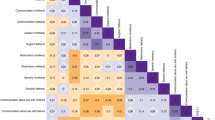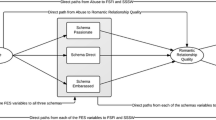Abstract
Unwanted sexual attention (UWSA) encompasses unsolicited verbal comments, gestures, stares, and other noncontact behaviors made regarding one's sexuality and physical appearance. The present study examined the correlates and impact of such UWSA perpetrated toward girls by family members. The first objective of the study was to explore whether family climate is associated with intrafamilial UWSA. This included looking at three types of dysfunctional parenting styles (unaffectionate, unavailable, and patriarchal) as well as exploring the co-occurrence of UWSA by adult and child relatives. The second objective was to then measure the impact of such intrafamilial UWSA on childhood emotional health, after controlling for parenting style and the experience of more traditional forms of child sexual abuse (CSA). Of the 296 university women (mean age = 19) who participated in the study, 70% (N = 206) reported UWSA from a family member prior to age 18. Whereas each dysfunctional parenting style was related to presence of UWSA, a simultaneous multiple regression analysis indicated that two of the parenting styles, patriarchal and parental unavailability, also predicted frequency of nonphysical UWSA within the family. Presence of UWSA from a child relative was significantly correlated with presence of UWSA from an adult relative. Additionally, a hierarchical multiple regression, entering the three parenting styles simultaneously in the first step, childhood sexual abuse in the second step, and familial UWSA in the last step, indicated that the frequency of UWSA by family members significantly predicted poorer childhood mental health when controlling for the other variables. Overall, results indicate that while the specific parenting styles which co-occur with UWSA may be detrimental in their own right, the impact of UWSA on girls appears to be above and beyond that of either parenting styles or CSA. Clinical implications are discussed.
Similar content being viewed by others
REFERENCES
Alexander, P., and Lupfer, S. (1987). Family characteristics and long-term consequences associated with sexual abuse. Arch. Sex. Behav. 16: 235–245.
American Association of University Women Educational Foundation (1992). How Schools Shortchange Girls, American Association of University Women, Washington, DC.
American Association of UniversityWomen Educational Foundation (1993). Hostile Hallways: The AAUW Survey on Sexual Harassment in America's Schools, American Association of University Women, Washington, DC.
Boney-McCoy, S., and Finkelhor, D. (1996). Is youth victimization related to trauma symptoms and depression after controlling for prior symptoms and family relationships? A longitudinal, prospective study. J. Consult. Clin. Psychol. 64: 1406–1416.
Browne, A., and Finkelhor, D. (1986). Impact of child sexual abuse: A review of the research. Psychol. Bull. 99: 66–77.
Cooley, C. H. (1902). Human Nature and the Social Order, Scribners, New York.
Cutler, S. E., and Nolen-Hoeksema, S. (1991). Accounting for sex differences in depression through female victimization: Childhood sexual abuse. Sex Roles 24: 425–438.
DiLillo, D. K., and Long, P. J. (1999). Perceptions of couple functioning among female survivors of child sexual abuse. J. Child Sex. Abuse 7: 59–76.
Draijer, N., and Langeland, W. (1999). Childhood trauma and perceived parental dysfunction in the etiology of dissociative symptoms in psychiatric inpatients. Am. J. Psychiatry 156: 379–385.
Edwards, J. J., and Alexander, P. C. (1992). The contribution of family background to the longterm adjustment of women sexually abused as children. J. Interpers. Violence 7: 306–320.
Faust, J., Runyon, M., and Kenny, M. (1995). Family variables associated with the onset and impact of intrafamilial childhood sexual abuse. Clin. Psychol. Rev. 15: 443–456.
Finkelhor, D. (1979). Sexually Victimized Children, The Free Press, New York.
Finkelhor, D. (1980). Risk factors in the sexual victimization of children. Child Abuse Negl. 4: 265–273.
Finkelhor, D. (1984). Child Sexual Abuse: New Theory and Research, The Free Press, NewYork.
Garner, D. M., Olmsted, M. P., and Polivy, J. (1983). Development and validation of the multidimensional eating disorder inventory for anorexia and bulimia. Int. J. Eat. Disord. 2: 14–34.
Herman, J. L. (1981). Father-Daughter Incest, Harvard University Press, Cambridge, MA.
Herman, J. L., and Hirschman, L. (1981). Families at risk for father-daughter incest. Am. J. Psychiatry 138: 967–970.
Irwin, H. J. (1996). Traumatic childhood events, perceived availability of emotional support, and the development of dissociative tendencies. Child Abuse Negl. 20: 701–707.
Jackson, J. L., Calhoun, K. S., Amick, A. E., Maddever, H. M., and Habif, V. L. (1990). Young adult women who report childhood intrafamilial sexual abuse: Subsequent adjustment. Arch. Sex. Behav. 19: 211–221.
Jumper, S. (1995). A meta-analysis of the relationship of child sexual abuse to adult psychological adjustment. Child Abuse Negl. 19: 715–728.
Kendall-Tackett, K. A., Williams, L. M., and Finkelhor, D. (1993). Impact of sexual abuse on children: A review and synthesis of recent empirical studies. Psychol. Bull. 113: 164–180.
Kuyken, W., and Brewin, C. R. (1995). Autobiographical memory functioning in depression and reports of early abuse. J. Abnormal Psychol. 104: 585–591. Intrafamilial Unwanted Sexual Attention 165
Leitenberg, H., Greenwald, E., and Tarran, M. J. (1989). The relation between sexual activity among children during preadolescence and/or early adolescence and sexual behavior and sexual adjustment in young adulthood. Arch. Sex. Behav. 18: 299–313.
Lipovsky, J., Saunders, B., and Hanson, R. (1992). Parent-child relationships of victims and siblings in incest families. J. Child Sex. Abuse 1: 35–49.
Love, L. C. (1994). Childhood sexual abuse: Determinants of risk to stepdaughters. Diss. Abstr. Int. 56-02A: 0463. Doctoral Dissertation, University of Georgia, 1994.
Love, L. C., Whealin, J. M., Jackson, J. L., and Ray, K. C. (1994, November). Verbal sexual attention to children: A normative phenomenon? Paper Presented at the Annual Meeting of the Association for the Advancement of Behavior Therapy, San Diego, CA.
Lynskey, M. T., and Fergusson, D. M. (1997). Factors protecting against the development of adjustment difficulties in young adults exposed to childhood sexual abuse. Child Abuse Negl. 21: 1177–1190.
Mannarino, A. P., Cohen, J. A., and Berman, S. R. (1994). The relationship between preabuse factors and psychological symptomatology in sexually abused girls. Child Abuse Negl. 18: 63–71.
Melchert, M. H. (2000). Clarifying the effects of parental substance abuse, child sexual abuse, and parental caregiving on adult adjustment. Profession. Psychol. Res. Pract. 31: 64–69.
Neumann, D. A., Houskamp, B. M., Pollock, V. E., and Briere, J. (1996). The long-term sequelae of childhood sexual abuse in women: A meta-analytic review. Child Maltreatment 1: 6–16.
Parker, S., and Parker, H. (1991). Female victims of child sexual abuse: Adult adjustment. J. Fam. Violence 6: 183–197.
Paveza, G. (1988). Rick factors in father-daughter child sexual abuse: A case control study. J. Interpers. Violence 3: 290–306.
Ray, K. C., and Jackson, J. L. (1997). Family environment and childhood sexual victimization: A test of the buffering hypothesis. J. Interpers. Violence 12: 3–17.
Reed, D. L., Thompson, J. K., Brannick, M. T., and Sacco, W. P. (1991). Development and validation of the Physical Appearance State and Trait Anxiety Scale (PASTAS). J. Anx. Disord. 5: 323–332.
Rind, B., and Tromovitch, P. (1997). A meta-analytic review of findings from national amples on psychological correlates of child sexual abuse. J. Sex Res. 34: 237–255.
Rind, B., Tromovitch, P., and Bauserman, R. (1998). A meta-analytic examination of assumed properties of child sexual abuse using college samples. Psychol. Bull. 124: 22–53.
Russell, D. E. H. (1983). The incidence and prevalence of intrafamilial and extrafamilial sexual abuse of female children. Child Abuse Negl. 7: 133–146.
Russell, D. E. H. (1984). Sexual Exploitation: Rape, Child Sexual Abuse, and Workplace Harassment, Sage, Beverly Hills.
Russell, D. E. H. (1986). The Secret Trauma: Incest in the Lives of Girls and Women. Basic Books, New York.
Weiner, K. E., and Thompson, J. K. (1997). Overt and covert sexual abuse: Relationship to body image and eating disturbance. Int. J. Eat. Disord. 22: 273–284.
Whealin, J. M. (1996). The Sexual Abuse and Sexual Harassment of Children: A Continuum of Behaviors? Unpublished master's thesis, University of Georgia, Athens, Georgia.
Whealin, J. M., and Jackson J. L. (1996, November). Sexual harassment during childhood. Paper Presented at the Annual Meeting of the Association for the Advancement of Behavior Therapy, New York.
Author information
Authors and Affiliations
Corresponding author
Rights and permissions
About this article
Cite this article
Whealin, J.M., Davies, S., Shaffer, A.E. et al. Family Context and Childhood Adjustment Associated with Intrafamilial Unwanted Sexual Attention. Journal of Family Violence 17, 151–165 (2002). https://doi.org/10.1023/A:1015009501050
Issue Date:
DOI: https://doi.org/10.1023/A:1015009501050




